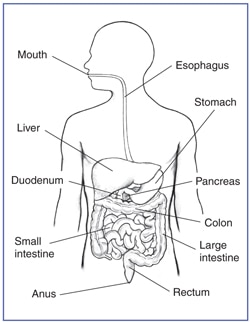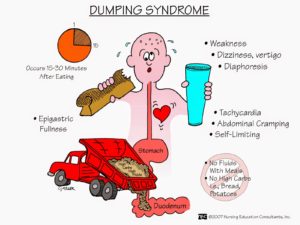What is dumping syndrome?
Dumping syndrome occurs when food, especially sugar, moves too fast from the stomach to the duodenum—the first part of the small intestine—in the upper gastrointestinal (GI) tract. This condition is also called rapid gastric emptying. Dumping syndrome has two forms, based on when symptoms occur:
- early dumping syndrome—occurs 10 to 30 minutes after a meal
- late dumping syndrome—occurs 2 to 3 hours after a meal
What is the GI tract?
The GI tract is a series of hollow organs joined in a long, twisting tube from the mouth to the anus—the opening where stool leaves the body. The body digests food using the movement of muscles in the GI tract, along with the release of hormones and enzymes. The upper GI tract includes the mouth, esophagus, stomach, duodenum, and small intestine. The esophagus carries food and liquids from the mouth to the stomach. The stomach slowly pumps the food and liquids into the intestine, which then absorbs needed nutrients. Two digestive organs, the liver and the pancreas, produce digestive juices that reach the small intestine through small tubes called ducts.
The last part of the GI tract—called the lower GI tract—consists of the large intestine and anus. The large intestine is about 5 feet long in adults and absorbs water and any remaining nutrients from partially digested food passed from the small intestine. The large intestine then changes waste from liquid to a solid matter called stool. Stool passes from the colon to the rectum. The rectum is located between the last part of the colon—called the sigmoid colon—and the anus. The rectum stores stool prior to a bowel movement. During a bowel movement, stool moves from the rectum to the anus.

What causes dumping syndrome?
Dumping syndrome is caused by problems with the storage of food particles in the stomach and emptying of particles into the duodenum. Early dumping syndrome results from rapid movement of fluid into the intestine following a sudden addition of a large amount of food from the stomach. Late dumping syndrome results from rapid movement of sugar into the intestine, which raises the body’s blood glucose level and causes the pancreas to increase its release of the hormone insulin. The increased release of insulin causes a rapid drop in blood glucose levels, a condition known as hypoglycemia, or low blood sugar.
Who is more likely to develop dumping syndrome?
People who have had surgery to remove or bypass a significant part of the stomach are more likely to develop dumping syndrome. Some types of gastric surgery, such as bariatric surgery, reduce the size of the stomach. As a result, dietary nutrients pass quickly into the small intestine. Other conditions that impair how the stomach stores and empties itself of food, such as nerve damage caused by esophageal surgery, can also cause dumping syndrome.
What are the symptoms of dumping syndrome?
The symptoms of early and late dumping syndrome are different and vary from person to person. Early dumping syndrome symptoms may include
- nausea
- vomiting
- abdominal pain and cramping
- diarrhea
- feeling uncomfortably full or bloated after a meal
- sweating
- weakness
- dizziness
- flushing, or blushing of the face or skin
- rapid or irregular heartbeat
The symptoms of late dumping syndrome may include
- hypoglycemia
- sweating
- weakness
- rapid or irregular heartbeat
- flushing
- dizziness
About 75 percent of people with dumping syndrome report symptoms of early dumping syndrome and about 25 percent report symptoms of late dumping syndrome. Some people have symptoms of both types of dumping syndrome.1
